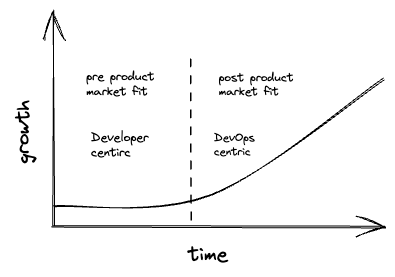In the early days of a SaaS business, engineering teams often undergo a crucial transformation from a Developer-centric mindset to a DevOps mindset. This transition usually occurs when the product achieves the right market fit, propelling the company into a phase of rapid growth. Such a shift becomes imperative due to the increasing customer base, evolving customer needs, and expanding team sizes. To prepare the company for the next phase, fundamental changes are necessary. At this point, selecting the right toolset not only reduces the pressure on the team but also enhances productivity.

Operating and managing the complex infrastructure required for SaaS applications is no easy feat. Scaling this infrastructure to meet future demands without the right tooling can be arduous and error-prone. The complexity arises from the adhoc nature of product development in the early stages, compounded by the variety of available tools for the job. Enter Infrastructure-as-code (IaC), a process that streamlines infrastructure provisioning and management. IaC enables seamless expansion, minimizes human errors, and reduces downtime, providing invaluable benefits such as:
Version Control and Collaboration: Growing teams in SaaS businesses consist of multiple engineers working on various components of the infrastructure. Managing these changes effectively can be challenging without proper coordination. IaC helps mitigate this challenge by leveraging version control systems like Git. All infrastructure changes are tracked and documented, allowing for easy rollbacks and efficient collaboration among team members. This approach not only improves productivity but also helps maintain a reliable and stable infrastructure.
Continuous Integration and Continuous Deployment (CI/CD): To stay competitive, SaaS businesses need to iterate and deploy updates to their services rapidly. Implementing CI/CD pipelines with IaC significantly speeds up the deployment process while ensuring consistency across environments. Automated testing and validation of infrastructure code within the CI/CD pipeline reduce the risk of errors in production, giving growing teams more confidence to deploy changes frequently.
Improved Disaster Recovery and Reliability: Unplanned outages can severely impact a SaaS business’s reputation and revenue. Infrastructure as Code facilitates disaster recovery by defining backup and restore procedures in the code itself. This allows teams to quickly recreate the entire infrastructure in case of failures or during migration to different cloud providers. With IaC, reliability is enhanced as the infrastructure is consistently deployed in the same manner, reducing the chances of configuration drift and unintended discrepancies between environments.
Cost Optimization: As SaaS businesses grow, cost management becomes crucial. IaC enables teams to codify cost optimization measures by defining resource configurations that align with the organization’s cost and performance objectives. This ensures that the infrastructure is right-sized, eliminating unnecessary expenses and optimizing cloud resource utilization.
There are multiple open-source and commercial tools available for IaC. Broadly, those could be bucketed into the following categories:
Declarative
Declarative Infrastructure as Code (IaC) tools allow users to describe the desired state of the infrastructure without specifying the step-by-step instructions to achieve that state. These tools focus on defining the desired configuration, and the tool itself takes care of managing the underlying resources to reach that state. Some popular declarative IaC tools are Terraform, Google Cloud Deployment Manager, and Azure Resource Manager. K8s is one more very widely used declarative provisioning and management tool for containerized applications.
Imperative
On the other hand, Imperative IaC tools can be more expressive when dealing with complex configurations or specific use cases, as they allow greater control over the execution flow. However, they may require more detailed maintenance, especially as infrastructure configurations evolve over time. Additionally, imperative IaC tools may involve more explicit error handling and retries to handle transient failures during execution. A few common imperative tools are Ansible, Chef, and Puppet.
The choice between declarative and imperative IaC tools depends on factors like the team’s preference, the complexity of the infrastructure, the level of control required, and the existing infrastructure management practices in the organization. Some teams might even choose to use a combination of both declarative and imperative IaC tools for different parts of their infrastructure, based on the needs of each component.
At Kapstan, we have successfully deployed and managed our infrastructure using Terraform. This choice not only allowed us to scale our engineering team by 4x in the last two months without disruption but also enabled new engineers to be productive immediately. By embracing the DevOps mindset and adopting the right IaC tools, SaaS businesses can effectively navigate the growth phase while ensuring seamless and efficient management of their infrastructure.
We are developing a no-cost tool designed to assist startups in seamlessly transitioning their AWS infrastructure to Infrastructure as Code (IaC). Stay tuned and if you are interested reach out to us at hi@kapstan.io.
